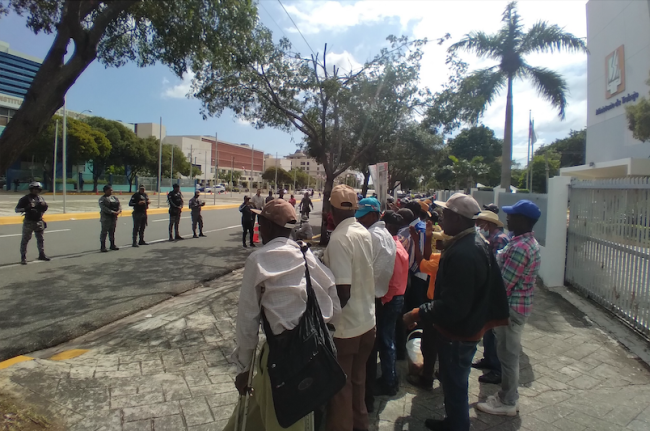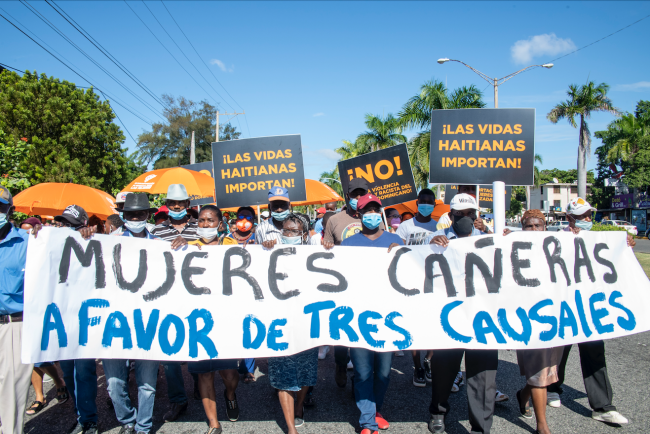
This piece appeared in the Fall 2023 issue of NACLA's quarterly print magazine, the NACLA Report. Subscribe in print today!
Leer este artículo en español.
It’s seven in the morning, and the day’s first light casts long shadows on the dirt roads of the batey. Two hours away from Santo Domingo, the rural community with roots in sugar cane has continued to grow despite being abandoned a quarter century ago by the Consejo Estatal del Azúcar, the state body overseeing sugar mill operations. One family has spent the night in funeral prayers, and the deceased woman’s son—who we’ll call Armando to protect his safety—heads out to get something for breakfast. When he returns, he hears shouts from eight police officers surrounding the house. Two young people are already detained, and the police are requesting documents from the others. Nobody tries to flee. “Why are they taking people away?” Armando questions, trying to film. “There are no criminals here!”
“Documents, moreno!” an officer yells at him, swiping to snatch away his cell phone. Armando’s brother-in-law knows one of the police and intervenes to prevent his arrest. Armando hands over his ID. “Are you in the military?” the officer asks, pointing to the words on the back of the card: “No vota.” They let Armando go and release one of the two detainees. They take the other to the police station, where they demand a ransom of 30,000 pesos, approximately $550. The man is the husband of one of Armando’s cousins. The family cannot pay, and the man is deported. Days later he will return, paying other police and soldiers along the way to be allowed to pass.
Two weeks later, in the same community, another “operation” strikes at dawn. Breaking down doors despite not having a search warrant, immigration agents enter homes and get people out of their beds. They take 10 more “morenos,” among them one of Armando’s childhood friends. They steal detainees’ cell phones and ask for 15,000 pesos to release each one. Some are Haitian immigrants, and others are Dominicans with Haitian parents or grandparents.
Shortly before this second operation, President Luis Abinader had vociferously rejected calls from the United Nations High Commissioner for Human Rights to suspend mass deportations of Haitians and to make an effort to prevent racial discrimination. “The Dominican Republic is not only going to continue deportations, but it is going to increase them,” Abinader threatened. “[The country] has been economically affected [and] has shown much more solidarity [with Haiti] than all the countries in the world.” That day, November 12, 2022, Abinader signed decree 668-22, creating a special police unit to persecute foreigners occupying state or private land. This is the situation in most bateyes, often home to Haitians and Dominicans of Haitian descent. The decree established consequences including expulsion and a ban on re-entering the country.
The mass deportation campaign hit a record 171,000 expulsions in 2022, almost all targeting Haitians. That number is more than triple the annual average of the previous five years and 20 times more than the total number of deportations in 2011. The rate continues to rise: in the week of May 30 to June 6, 2023, 4,603 people were expelled, all Haitians except for one person from the United States and one from Poland. Among those deported are thousands of children separated from their families and hundreds of pregnant women, many of them detained in and near hospitals. Torture, rape, and murder have been reported. The government has celebrated this “successful” campaign, boosting it with the largest purchase of military equipment since 1961, the last year of the Trujillo dictatorship, in the name of containing the supposed Haitian threat.
When the Dominican government launched a deportation campaign based on racial profiling in January 2004, a human rights lawyer called the policy “Caribbean-style apartheid.” Today, not only are the numbers of mass deportations much higher, but authorities have also consolidated policies of racial oppression, such as the mass denationalization of Dominicans of Haitian descent, which Noémie Boivin has analyzed as an act of apartheid under international law. In this effort to build apartheid in the Caribbean, the Dominican state has relied for many years on an important supplier of weapons and police and military training, as well as political inspiration: the Israeli apartheid regime.
Racist Denationalization
Armando is 34 years old. He is not a foreigner or a member of the military, but the state does not consider him Dominican, which is why his ID indicates that he’s not allowed to vote. His maternal grandparents arrived from Haiti in 1968, during the dictatorship of Joaquín Balaguer, to work in the sugar industry. His mother was born in the Dominican Republic, just like him. On September 23, 2013, Constitutional Court ruling 168-13 required people born in the Dominican Republic to foreign parents after 1929 to prove their parents’ immigration status to retain Dominican nationality. In practice, this court ruling was applied only to people of Haitian descent. Armando was made stateless, alongside some 200,000 other people, according to UN estimates.
Young people impacted by the ruling mobilized, pushing the government of Danilo Medina to introduce Law 169-14, which divided the people affected into two groups. Those in Group A, who already had Dominican identity documents, regained their nationality but were added to a racially segregated civil registry. Those in Group B, including Armando, lost their citizenship status but were allowed to enter a regularization plan for foreigners, with the promise that they would be eligible for naturalized citizenship in two years. Nine years after Law 169-14 was introduced, the Movimiento Reconocido, a civic network of Dominicans of Haitian descent, denounced that of the more than 8,000 people who applied for the regularization program, not one had yet been granted naturalized citizenship.
Armando’s ID expired two years ago, and there is no procedure to renew it. Like thousands of people in his situation, he fears being arrested and extorted by the military and police, or being expelled from the country. He does not have recognized political rights. He cannot go to university, have a formal job, open a bank account in his name, or receive health insurance. In the eyes of the state, he is a Haitian without a visa—an “illegal.”
According to some official estimates, most Haitian immigrants—around 700,000 people—do not have a residence visa, even after decades of working in the country. Added together, Dominicans of Haitian descent and Haitian immigrants represent 8 percent of the Dominican population, and their labor force is crucial in industries such as sugar and other agricultural products, construction, and services. Even the government exploits Haitian workers on official construction sites, including the project to expand the wall on the border with Haiti. Initially, the authorities were in talks with Israeli companies to provide surveillance technology along the wall, which is expected to cover half of the 244-mile Haitian-Dominican border, but for economic reasons, the government ultimately opted for other providers.

The New Phase of Anti-Haitianism
Amid the 1937 massacre known as El Corte, during which the Trujillo regime murdered more than 17,000 Haitians and Dominicans of Haitian descent near the border, the boy who would later be known as José Francisco Peña Gómez was separated from his mother. He was less than one year old. He had Haitian ancestry on both sides of his family and was adopted and raised by another Dominican family after the massacre. From a young age, he stood out as a politician, and he played an important role in the April Revolution of 1965, which sought to restore President Juan Bosch to power after a coup two years earlier.
In August 1982, the remains of Peña Gómez’s mother, María Marcelino, were repatriated. She had taken refuge in Haiti in 1937 together with thousands of Black Dominicans and Haitians. During the burial in Santo Domingo, Peña Gómez recalled the “people fanaticized by anti-Haitianism and racism” who falsely accused him of “usurping” Dominican nationality. “Haitians are considered by certain social sectors who invoke a false Spanishness to be inferior beings, subhuman,” he said in a speech. “For this reason, for all the years of my life I have silently endured the most inconsiderate racist insults, and I have often heard people poisoned by hate shout at me: Haitian! It is a name that has acquired a pejorative and denigrating meaning…despite being the name that the inhabitants of a nation with a great history proudly bear.”
Peña Gómez died in 1998, but his words remain relevant. No leader of any of the establishment’s political parties would be able to utter similar pronouncements today. Ruling 168-13 institutionalized and expanded the practice of disputing the nationality of Dominicans of Haitian descent, which Peña Gómez suffered personally in the form of dirty political campaigns. Abinader, who claims to uplift Peña Gómez’s legacy, campaigned in 2019 calling to “prevent the merger of the Dominican Republic and Haiti” and characterizing Haitian immigration as a threat to national independence. From the beginning of his government, Abinader upheld a definition of Haitians as the “foremost threat” to the country, creating the political conditions for the current campaign of racist persecution.
Dominican apartheid is ideologically based on historical anti-Haitianism, which has its roots in colonial slaveholders’ fears of Black rebellion and their resentment over the abolition of slavery during the island’s political unification between 1822 and 1844. This is why, in the first years after the separation of the Dominican Republic and Haiti, the accusation of “negrophilia,” love of Blackness, was synonymous with treason against the Dominican homeland, much as the term “pro-Haitian” is today. Such accusations were even used to justify executions, such as that of the prominent military officer José Joaquín Puello in 1847.
Denialists of the Dominican state’s racism habitually attribute the 1937 massacre exclusively to Trujillo, as if it were an individual crime. But in addition to the fact that the massacre’s objectives had broad support among an intelligentsia that continues to hold political sway today, it is undeniable that the ethnic cleansing program has been recreated in contemporary form. The current government claims to act in the name of repelling the “demographic threat” and “Dominicanizing the border.” Article 10 of the constitution, which was reformed in 2015, establishes a border property regime that privileges “the property of Dominicans,” thus shielding the land thefts perpetrated in 1937.
Abinader is in fact more of a political heir to Balaguer, whose different presidencies spanned more than two decades. Balaguer described Haiti as the main threat to the Dominican nation. In his book La isla al revés, he disguised the goal of recolonizing Haiti under the misleading formula of a binational federation. Abinader’s constant agitating in support of international military intervention and occupation of Haiti in the name of “pacification” can be understood as a new iteration of the Balaguer-style reactionary vision of putting an end to Haitian self-determination.
Read the rest of this article, available open access for a limited time.
Simón Rodríguez is a freelance journalist and researcher based in the Dominican Republic.

